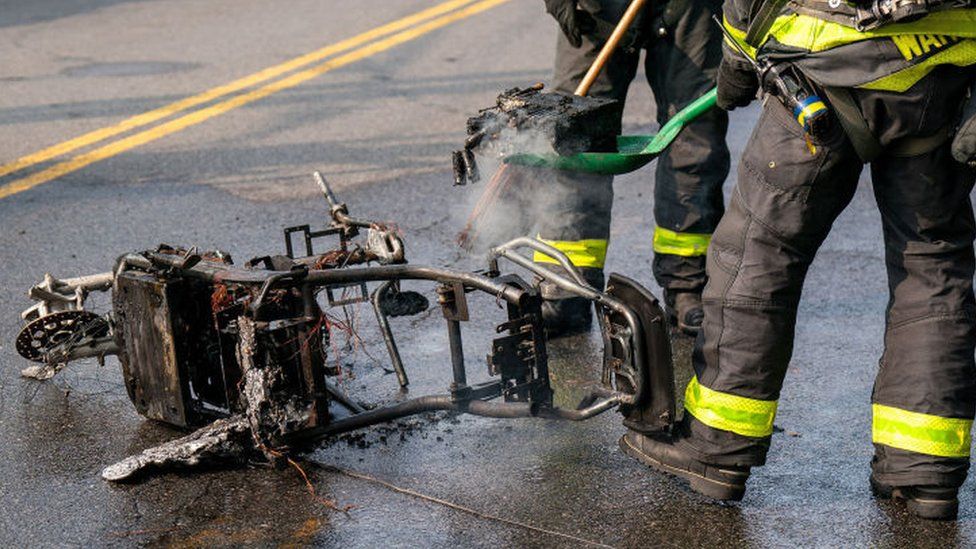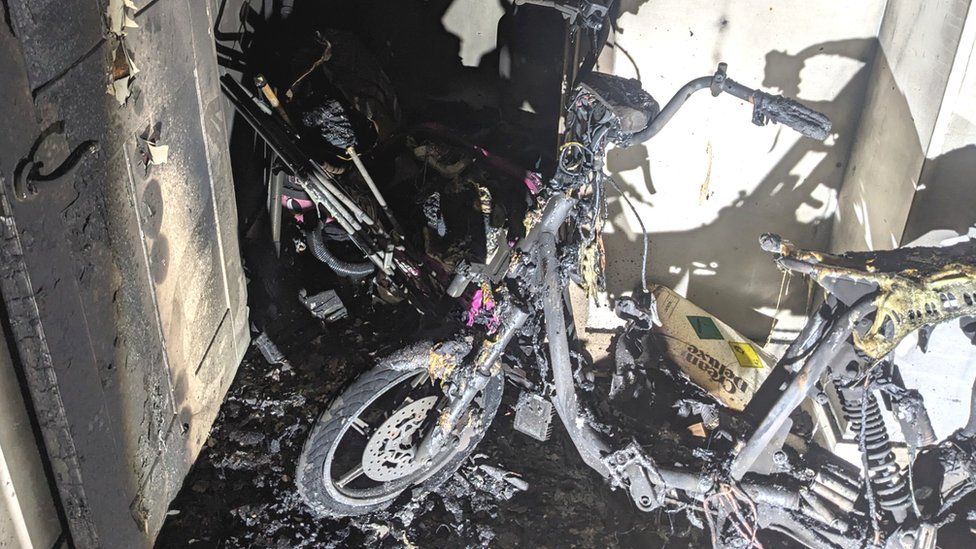Why the e-bike boom is raising fire fears


When Ollie, a delivery rider in York, England, got his first e-bike in 2022, it was a bit of a splurge. He bought it at a discounted rate negotiated by his delivery company.
Even with the discount, it set him back £1,000.
“The biggest issue is that e-bikes are expensive, and ones with safe batteries are extremely expensive, so many people opt for cheaper, less reliable and often dangerous batteries,” Ollie says.
While he was initially tempted by cheaper models, he ultimately decided that investing in a better e-bike would pay off in terms of “higher range, safer batteries, easier access to repairs and a solid warranty”.
While that might have been true, it also made his bike an attractive target – his e-bike was recently stolen outside a supermarket.
He has no plans to buy a replacement.
“Spending £1,000 on an e-bike or buying a bike at all that stands out would just be shooting myself in the foot,” Ollie believes.
The market for electric bikes, scooters and mopeds is expanding, which is a positive trend for cutting carbon emissions. Studies show they have a low carbon footprint, .

“E-bikes are the most promising equitable climate solution in the transportation space that we have seen,” says Melinda Hanson, the cofounder of the Equitable Commute Project. This organisation assists lower-income New Yorkers to access e-bikes, for instance through events where delivery workers can trade in their non-certified e-bikes for discounted new bikes that meet safety standards.
This reflects the electrical safety risks of electric two-wheelers. In China, the world’s e-bike centre, and in cities like London, where e-bikes caught on later, the number of fires caused by e-bikes and e-scooters is increasing.
The insurer Aviva has been seeing customer claims “related to fires which started due to rechargeable e-bikes exploding during charging, including claims involving failed e-bike batteries and e-bikes purchased second-hand,” comments Hannah Davidson, a senior underwriting manager for Aviva.
Aviva reports that 71% of adults surveyed in the UK didn’t know the signs that a lithium-ion battery, the type found in e-bikes and e-scooters, is on the verge of failure. These warning signs include heating, leaking, swelling, and unusual smells and noises.
Fires caused by lithium-ion batteries are vicious. “These fires are not so much traditional fires. They’re explosive and there’s a lot of gas involved,” explains Robert Slone, the senior vice president and chief scientist for UL Solutions, a safety science company.
These fires also spread incredibly quickly, making it challenging for firefighters to respond in time.

The rapid rise of e-bikes means that regulations have been lagging behind the market. For instance, the UK lacks regulations on e-bike chargers or kits to convert standard bikes into electric ones. And in many places, a shadowy international market for e-bike parts flourishes online.
Incompatible and uncertified batteries are major contributors to fire risks. In New York City, “one of the main issues with the most popular battery model that’s out there right now is that it’s really flooded with counterfeit batteries,” explains Ms Hanson.
Third-party batteries are risky because “the way to ensure that these bikes are as safe as possible is to make sure that the battery, the motor and the charger were all designed to work together”.
Even if an e-bike kit is safe at the point of sale, later modifications can create incompatibilities. Mr Slone explains, “It could be a perfectly safe battery pack, but if it’s a mismatched charger that perfectly safe battery pack can become a very significant safety hazard and can go into what’s called thermal runaway.”
Thermal runaway is a kind of explosive chain reaction where a cell inside a lithium-ion battery overheats, which then spreads to the many other cells in the battery.


Yet for people on tight incomes (such as the delivery riders earning less than the minimum wage), manufacturer-approved components and reputable repair shops may be out of reach. Also impractical for many is charging outside, or in a purpose-built facility.
For riders who have no alternative to charging their e-bikes within their homes, there are ways to limit the fire risks. “Don’t block the exit to your home,” Mr Slone emphasises.
To give people a chance of escape, any means of delaying the spread of a fire or toxic gas can help. “Even if someone doesn’t have a dedicated storage cabinet, if they have a room that’s enclosed with doors that’s away from where they sleep, that might be safer than leaving it in kind of a common area,” says Mr Slone. It can also help to keep e-bikes away from flammable materials.
The London Fire Brigade has advised riders to let their batteries cool down before recharging, charge on flat hard surfaces, avoid extreme temperatures, and keep fire alarms in good condition.

Another frequently dispensed piece of advice is to never leave a charging battery unattended, especially overnight.
For a delivery cyclist working a 14-hour shift, “the most natural thing in the world would be to come home at the end of your shift, plug your bike in…right there at the door, and go to bed,” Mr Slone notes. But it can have tragic consequences.
Regulations have started sprouting in response, particularly in the past year. China, a major exporter of e-bikes and batteries, recently implemented national safety standards for e-bike chargers and electrical systems.
In New York City, sold or rented e-bikes and batteries are now required to be certified to the safety standards set by UL Standards and Engagement, the nonprofit parent organisation of Mr Slone’s company. These standards cover aspects like the risk of electric shock and safe battery storage.

“Getting these safer bikes and safer batteries that have intelligent battery management systems will go a long way toward ensuring safety, because those batteries tend to stop trying to pull any more energy,” Ms Hanson comments. “If there is an issue, they automatically shut themselves down and thereby reduce the risk.”
While some landlords have responded to fire risks by banning e-bikes in apartments altogether, in California a new law allows a tenant to store and charge one e-bike or other personal micro-mobility device indoors, provided that it meets certain safety standards.
Mr Slone believes that it would be game-changing “to have standards that cover charging facilities, so that people do not need to bring the battery pack or the bike up to their place where they live”.
Charging hubs, where many models of electric two-wheelers can be charged, are more common in some Asian countries. So too are battery swap cabinets, where riders can replace an empty battery with a charged one that’s compatible with their vehicle.
Ollie, who charged his battery in the living room of the student home he shared with two other people, says, “If e-bike batteries were synchronised and there was a place to swap them out mid-ride whilst out and about this would be great.”
Rather than fearmongering putting people off e-bikes, reasonable cautions and supportive infrastructure would allow cities to reap the many benefits of e-bikes while protecting lives. Funding should come from delivery companies, large food chains and governments, Ms Hanson believes.
“This is a technology that’s very much worth protecting… and worth investing in for our future,” Ms Hanson stresses.

